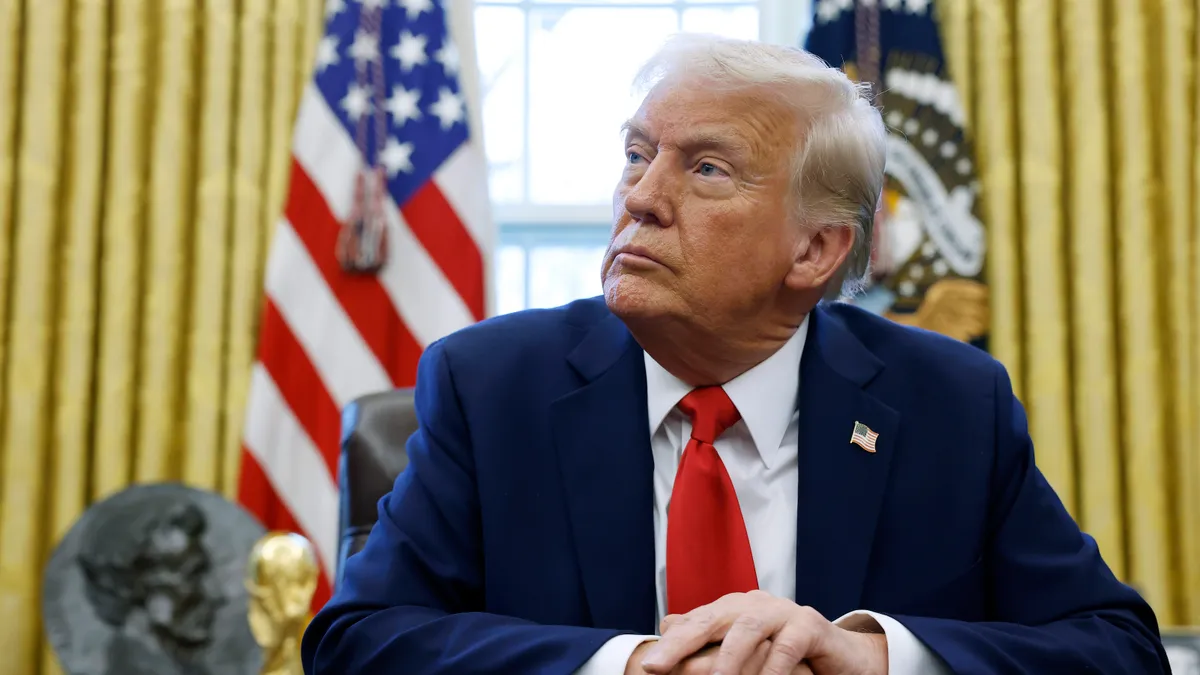President Donald Trump’s Jan. 29 executive order seeking to root out “radical indoctrination” in schools is an unprecedented effort to extend federal oversight over local and state decisions on curriculum, K-12 instructional and legal experts say.
The order directed the U.S. Department of Education and other federal agencies to end “funding or support for illegal and discriminatory treatment and indoctrination in K-12 schools, including based on gender ideology and discriminatory equity ideology.” The order defined “discriminatory equity ideology” as one that “treats individuals as members of preferred or disfavored groups, rather than as individuals, and minimizes agency, merit, and capability in favor of immoral generalizations.”
Additionally, Trump called for the reestablishment of the President’s Advisory 1776 Commission created during his first term “to promote patriotic education.”
A ‘chilling effect’?
While it’s difficult to know what this executive order will mean in practice, the directive echoes recent legislation in Republican-leaning states that have sought to restrict K-12 classroom discussions on topics involving gender, race and sexual orientation, said Brendan Gillis, director of teaching and learning at the American Historical Association.
As of October 2024, at least 21 states had laws, policies or executive orders targeting curriculum related to gender and sexuality, race or other “divisive concepts,” according to PEN America, a free speech advocacy organization tracking the issue.
“We can look at how the divisive concepts legislation that we've been seeing in dozens of states across the country have affected what teachers say and do,” Gillis said. “There's a growing body of research that shows that there's a chilling effect, even when it's not always entirely clear how you enforce some of these curriculum bans.”
A 2024 Rand Corp. survey found that almost two-thirds of public school teachers have opted to limit instruction on political and social issues due to the climate in their community and policies seeking to curb what they can teach. Even in places without curriculum restrictions, over half of teachers reported they decided to limit their lessons on these topics.
While some school district leaders have said they will not “bow down” to this executive order, those in states that have already implemented restrictions might have trouble pushing back, said Nicholas Hite, a senior attorney at Lambda Legal, a national LGBTQ+ civil rights organization.
“I think those schools are also really concerned about protecting their staff, their teachers and their students, but they're just not able to be quite as bold about it,” Hite said. “Because if nothing else, this executive order definitely turns on the green light for states to become far more hostile towards teachers and students.”
Legal implications
Hite said the executive order is an “obvious violation of the First Amendment” by trying to dictate what can or can’t be discussed in schools. Beyond that, he said, the directive also likely violates the 14th Amendment’s equal protection clause.
The order also violates several federal laws that bar federal involvement in school districts’ curriculum, Hite said.
Such laws include the Department of Education Organization Act and the Elementary and Secondary Education Act, according to The Leadership Conference on Civil and Human Rights.
For instance, the Department of Education Organization Act states that “no provision of a program administered by the Secretary or by any other officer of the Department shall be construed to authorize the Secretary or any such officer to exercise any direction, supervision, or control over the curriculum, program of instruction, administration, or personnel,” in any school or school system.
The Elementary and Secondary Education Act, as amended by the Every Student Succeeds Act, says that “No officer or employee of the Federal Government shall, through grants, contracts, or other cooperative agreements, mandate, direct, or control a State, local educational agency, or school's specific instructional content, academic standards and assessments, curricula, or program of instruction developed and implemented to meet the requirements of this chapter.”
But at this point, Hite said, Trump's executive order doesn’t require any school to immediately change its policy or practice.
“If a school is providing a safe, supportive and inclusive environment and curriculum for their marginalized students, please continue doing that,” Hite said. “This is just a lot of empty threats.”
A confusing time for districts
David Law, superintendent of Minnesota’s Minnetonka School District and president-elect of AASA, The School Superintendents Association, said his district is “not taking a knee jerk reaction” to this executive order given the many legal challenges from Trump’s other recent directives.
At the state level, Minnesota has enacted a Human Rights Act that instills protections for LGBTQ+ people, and it’s unclear if the executive order overrules that, Law said.
“President Trump said early on, ‘We’re going to push all these education issues to the state,’” Law said. “Well, for us, our state is telling us our Human Rights Act protects all of these rights.”
In addition, Minnesota recently passed a law requiring schools to teach the history of Native Americans and Indigenous people. Law questioned if those state-required lessons would be considered diversity, equity and inclusion efforts.
“It’s about clarification. And ironically, the entity that would provide guidance about that would be the Department of Education. So if they’re no longer in existence, it really is open to the interpretation of state-level people,” Law said.
Trump has long promised to seek an end to the U.S. Education Department. To that end, he is expected to soon issue an executive order to begin dismantling the 45-year-old agency.




















